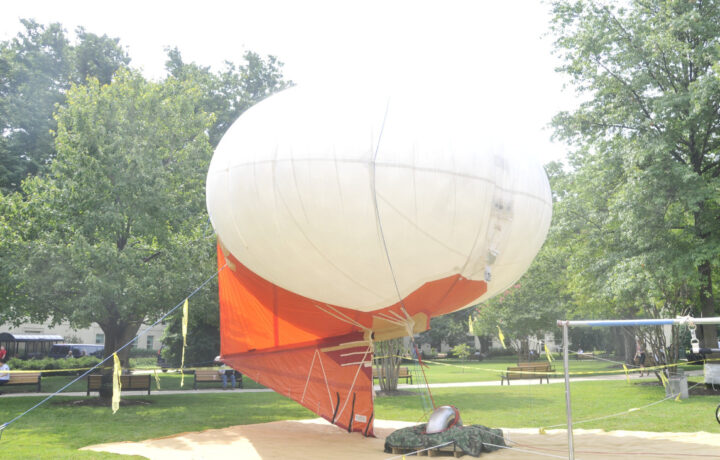On Thursday, the United States House of Representatives unanimously approved a resolution condemning the Chinese Communist Party (CCP) for its use of a spy balloon that traveled across the continental United States. Lawmakers labeled the incident “a brazen violation of United States sovereignty.”
The balloon was shot down by a United States Air Force Lockheed Martin F-22 Raptor on Saturday off the coast of South Carolina, intensifying tensions between Washington and Beijing.
Though some lawmakers have said this is an event that must never happen again, chances are that it will – and there isn’t likely much that can be done to stop it. It is estimated that Chinese surveillance balloons, which are equipped with tools to collect communications signals, have flown over more than 40 countries around the world.
Advanced Balloons
In an era of low earth orbit satellites and drones, balloons are still quite a viable weapon. Despite the size, these can present a fairly low radar signature, and unlike satellites or high-speed aircraft, a balloon can loiter over an area to gather intelligence.
For those reasons, NATO Secretary General Jens Stoltenberg also warned this week that such balloons should be seen to present security challenges for members of the 30-nation military alliance as well as other countries around the globe.
“The balloon over the United States confirms a pattern of Chinese behavior where we see that China has invested heavily in new capabilities, including different types of surveillance and intelligence platforms,” Stoltenberg said during a press conference in Washington, D.C. alongside U.S. Secretary of State Antony Blinken.
“We need to be aware of the constant risk of Chinese intelligence and step up what we do to protect ourselves and react in a prudent and responsible way,” the NATO chief added.
The CCP has previously maintained that it does not engage in espionage, while Beijing had tried to suggest that the balloon was for gathering weather-related data.
History of Balloons
The use of balloons in military observation actually dates back to the late 18th century. In 1794, the French Committee of Public Safety created the Corps d’ Aerostiers, and a number of balloons were sporadically used for reconnaissance during the French Revolutionary Wars, seeing action during the battles of Charleroi and Fleurus.
The United States military first employed balloons in a similar role during the American Civil War (1861-65). The largest – the Intrepid and the Union – each had a capacity of 32,000 cubic feet of lifting gas, which was supplied by special hydrogen-generating inflation wagons. The balloons were employed to monitor troop movements.
The First World War saw the high point for the military use of observation balloons, which were used extensively by both sides. Balloons assisted in helping artillery target enemy positions as the guns became capable of engaging targets far beyond the visual range of a ground-based observer. While the balloons could be defended by ground-based anti-aircraft, they increasingly came under attack from specialized “balloon busters” aircraft.
By the Second World War, surveillance balloons had evolved into “blimps” – non-rigid airships powered by a pair of Pratt & Whitney engines. These were used as part of the United States Navy’s anti-submarine efforts in the Atlantic and Pacific Oceans. Though lightly armed with just an M2 Browning .50 caliber machine gun, and carrying only four AN-Mk47 depth charges, the K-14 balloons, with a crew of nine to 10, helped combat enemy submarines on the open waters.
Cold War Observation Role
In the Cold War, it was actually the United States Air Force that then took a lead on balloon development, creating spy balloons that could take advantage of the high-altitude jet streams over the Soviet Union. In the early 1950s, a number of high-flying balloons were released and they floated across Soviet territory at upwards of 50,000 feet above sea level and out of the range of air defenses of the era. Beginning on January 10, 1956, some 448 spy balloons were eventually launched from Turkey and West Germany, where they slowly floated across the Soviet Union – which issued a formal protest note via diplomatic channels.
It was soon determined, however, by Soviet MiG pilots that the spy balloons would descend at night, where they could be shot down. As a result, an estimated 90% were lost. Yet, the 10% that made it across the country were recovered by U.S. warships or to bases in the Far East. Those spy balloons provided invaluable information about roughly a million square miles of Sino-Soviet territory.
It was also during the Cold War that a high-altitude balloon, developed for nuclear test surveillance, crashed near Roswell, NM in 1948. The efforts by the U.S. military to conceal the nature of the classified balloon resulted in the “UFO craze.”
U.S. Military Balloons Today
China isn’t alone in utilizing balloons even in the age of satellites. In recent years, the Pentagon invested about $3.8 million in balloon projects, and last year announced it would invest another $27.1 million in fiscal year 2023 (FY23), Politico.com reported last summer.
In addition to a surveillance role over an adversary, balloons that can float between 60,000 and 90,000 feet can be employed as communication and datalink nodes, and could be a critical tool in tracking hypersonic weapons. Whereas the balloons of the Cold War had to rely on the jet stream, advances in machine learning can allow the balloons to more accurately predict a course that takes them over high value targets.
These lighter-than-air craft won’t likely replace satellites and traditional aircraft, of course, but could supplement the work at a fraction of the cost. More than 225 years since the first balloons were employed by the French military; there remains a place for balloons today.




